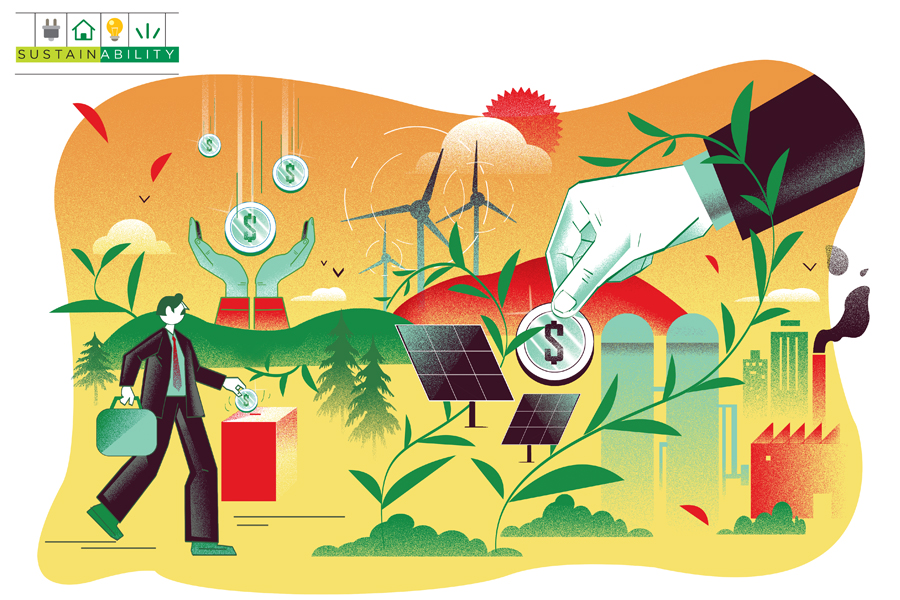ReNew Group Is Expanding With Green Bonds- The Growth Of Green Bonds In Post-Pandemic Era.
Since its inception in 2011, ReNew Group has received USD 2.1 billion in the equity investments in a myriad of tranches.

The gross debt of ReNew Energy Global, the Nasdaq-listed parent company of India’s ReNew Group, increased by a fifth in FY23. As per the data from an investor presentation provided by the business last week, it stood at INR53,085 crore after the fiscal year. Green bonds now value approximately a third of ReNew Energy Global’s debt profile. Green bonds (debt instruments) have fueled the Gurugram-based renewable energy company’s balance sheet to raise funding for environmentally beneficial initiatives, fulfil expansion requirements, and refinance debt. This has left market investors wondering about its capital strategy in the face of increasing interest rates across the world.

Renewable energy projects demand much upfront investment and have long gestation periods. Since its inception in 2011, ReNew Group has received USD 2.1 billion in the equity investments in a myriad of tranches. It was in the first Indian renewable energy company to sell masala bonds (rupee-denominated bonds issued outside India) in 2017. Since 2017, the corporation has raised USD 3.4 billion in green bonds. It has acquired funds through international loans and external commercial borrowings (ECBs). Due to excessive financial leverage, the corporations’ comprehensive capital raising has kept ReNew Power, the Indian unlisted part of ReNew Energy,’s credit profile limited.
Moody’s opinion- The expert cue.
The consolidated cash flow from operations pre-working capital/debt, or (CFO pre-WC)/debt, may fall below the 3.5% minimal tolerance threshold in fiscal 2024 due to projected capital investment that would peak in the fiscal year. This ratio is expected to rebound to 3.5% and 4% when new projects are completed in the following years.
The expert’s opinion voices that RPPL’s (ReNew Power) profits will grow after the next fiscal as its greenfield projects become operational and contribute to group earnings. However, the comparable progress in RPPL’s financial leverage will rely on the company’s expansion ambition and the extra debt needed to achieve the group’s development plans.
The era of Green Fever.
After Hyderabad-based renewable energy provider Greenko Group, Renew Energy is India’s largest issuer of green bonds. According to a June 6 Bloomberg Energy Finance study, Indian power providers issued USD 43 billion in green bonds between January 2014 and March 2023. In April, ReNew Energy Global raised USD 400 million through secured green bonds with a coupon of 7.95%, spicing up the high-yielding market for the first time in more than a year. Diamond II Ltd, a wholly-owned subsidiary of ReNew Energy, issued the bonds, but are guaranteed by the parent firm.

According to industry observers, the so-called scarcity premium assisted the business, which has a clean-energy portfolio of around 13.7 GWs, in pricing dollar notes lower than the initial projection of approximately 8.50% while simultaneously witnessing demand over USD 1.5 billion.
Why Indian green bonds are making a name across the world?
High-yielding green bonds issued by Indian companies are in high demand in the international market. This is because global investors like sovereign and hedge funds, asset managers, and insurers want to deploy billions of dollars to meet their ESG (environment, social, and corporate governance) mandates.
Bonds are vital because one can form structures around them. They do not bind one in the way that project financing does. Raising funds may be less expensive. One can obtain a more diverse source of cash. They don’t want to be invested in bank loans, dollar bonds, or rupee debt but rather in a diverse pool of money. Bonds work nicely in this context.

Renewable projects generally have an IRR of 12%-16% during their lifespan. The Central Electricity Regulatory Commission deems renewable energy projects to have a levered return on equity of 14%. The operating expenses are relatively cheap. However, annual cash flows may fluctuate depending on natural resource availability.
Is it a dangerous bet?
ReNew’s bond offerings have piqued the interest of renewable energy industry participants and corporate finance specialists for two reasons.
The first is the timing of the bond offering, which knocks at the time when interest rates rise, posing the dangers of currency instability. Overseas borrowing costs have increased dramatically in the last year as central banks across the world began to raise interest rates. For example, ReNew Energy’s latest green bond issue yields 7.95%, 345 basis points more than its last dollar note issuance in January 2022. Furthermore, for establishments like ReNew that have operating cash flows in Indian rupees, foreign currency concerns may be considerable.
The second factor is the company’s market selection. ReNew has local access to financing, particularly from banks eager to support renewable energy initiatives. So, why issue bonds in other countries? Banks have expressed interest in several of ReNew Power’s projects, says Kedar Upadhye, group chief financial officer, and the firm can raise bank loans with interest rates ranging from 8.50% to 8.75%. However, he reminds out that domestic bond markets are insufficiently developed. Furthermore, merchant bankers estimate that interest rates on such issuances would be higher than 10%-11%.
Green bonds were issued in April for two reasons.
- The first step was to repay a debt at the holding company level.
- Second, there were a few initiatives that received dollar loans. Dollar loans must be repaid in dollars alone, according to external commercial borrowing standards.

Debt financing is beneficial regarding return on equity. The principal payment is made on maturity in the case of dollar bonds. In the meanwhile, the issuer has the option of distributing any cash flow surplus to shareholders. However, when banks lend on projects, the cash flow is caught in monthly interest and principal payments, leaving equity investors out.
What is the role of the Capital structure?
Even though certain rating agencies describe ReNew’s capital-raising process as “complex,” investors appear to have no issues. The high demand for Diamond II’s green bonds demonstrates this. ReNew Power issues holding company bonds directly and through offshore financial entities India Clean Energy Holdings and Diamond II.
Borrowings are also made at the operating subsidiaries, with project bonds issued directly by restricted groups formed by RPPL’s operating subsidiary ReNew Wind Energy and indirectly through orphan vehicles, India Green Energy Holdings and India Green Power Holdings. ReNew Power and all of its subsidiaries are included in the restricted group.
Experts anticipate high investor demand for bonds issued at the limited group and holding company levels. Because cash flows are separated in the event of a limited group or the RG level, issuance is the most secure. Simply do RG and state that these projects have been securitised and collateralised. In the instance of the April green bond offering, the funds were put to numerous uses, and the firm had put together a robust security package.

While it is issued as debt, the usage of revenues from green bonds sold in April is more akin to equity. The firm can’t have this expense for conventional project finance if it can’t create an internal rate of return (IRR). This is done extremely carefully. RG-type issuances will be the preference, as well as investors’ preferences. ReNew intends to achieve a leveraged project equity IRR of 16%-20%.
It is believed the firm will earn a profit in FY25 as new capacity increases begin to yield fruit. ReNew Energy Global reported a net profit of INR 7.4 crore in the January-March quarter, primarily due to more significant revenues, compared to a net loss of INR 355.4 crore the previous year. Annually, the firm reduced its net loss to INR 502.9 crore in FY23 from INR 1,612.8 crore the last year.
The debt situation.
According to the company’s March quarter investor presentation, issued on June 7, a large portion of ReNew’s debt is at the project level, with only 14% on the holding company’s books. Green bonds account for 32% of ReNew’s total debt, while secured loans from financial institutions account for 36%. However, in terms of currency, 47% of the company’s debt is in US dollars (hedged), with the remainder in Indian rupees. While the corporation has no specific debt structure goals, it can be believed the present approximately 50:50 split is excellent since it provides a natural buffer. Each capital rise is tied to two primary goals: access and affordability.
Banks are interested because they are required to promote renewable energy. The rupee market has been quite supportive, although not always profound. Dollar debt is sometimes cheaper in terms of affordability. Everything is in the firm’s portfolio. It all depends on the currency rate and coupon rate in effect at the moment, as well as the security package and market depth. The bond refinancing was done in rupees, which resulted in huge savings. Last year, almost USD 1 billion in refinancing was done by saving 200 basis points in terms of interest rate on a fully loaded basis.
Once the projects are operating, refinancing becomes a normal function for the organisation. The exercise is advantageous because it generates more liquidity through top-up and release of current funds, improves accrual of internal cash flows due to bullet repayment arrangements in bonds, and makes limited payment conditions simpler to meet. Raising funds through asset churn and minority share sales has enabled the corporation to increase returns to more than 20%. It has also decreased capital spent to 5%-10% of project cost, as opposed to 25% if the business has 100% equity in the project, according to details in the Diamond II bond term sheet.
The instances of the collab.
ReNew announced a collaboration with Gentari, the sustainable energy subsidiary of Malaysian oil corporation Petronas, in May. Gentari will acquire 49% of ReNew’s 403 MW Peak Power project. ReNew’s capability to refinance debt is supported by several factors, including internal accruals, a strong cash balance of more than USD 900 million till 03.2023, an asset-recycling strategy, and the support of shareholders like the Canada Pension Plan Investment Board and the Abu Dhabi Investment Authority.
Budget forecast of the company, The ReNew.
ReNew has said that the development of 1,750 MW-2,250 MW of renewable energy will be completed by the end of Fiscal Year 2024. According to the company’s March quarter investor presentation, capital expenditure for FY24 is expected to range in INR 13,000 and INR 15,000 crore. The firm commissioned 414 MW of projects in the earlier fiscal year, costing INR 2,452 crore.
According to data from the Central Electricity Authority, India increased its solar power-producing ability from 5,459 MW to 13,910 MW each year beginning in April 2019. This creates a contradiction sharply with the government’s statement of a 40-GW annual solar plan to meet the 500-GW non-fossil fuel capacity goal by 2030.
So, with annual capability additions having plateaued over the last two fiscal years, what does the future hold for the renewable energy sector and entities like ReNew Energy?
For now, investors and bondholders who have placed their confidence in the India development narrative and ReNew Group are hoping for better times.
Conclusion.
A long-term policy by the Central and State level authorities to encourage renewable energy and provide the required infrastructure and equal playing field for all stakeholders is critical. Renew Power’s operations must be very efficient and well-managed. Then they can thrive.
Proofread & Published By Naveenika Chauhan





